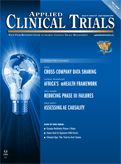eConsent Study Provides Insights to Shape Industry Adoption
Applied Clinical Trials
Janssen releases key findings from its pilot study evaluating the use of electronic informed consent technology in clinical trials.
The drawbacks of today’s paper-based informed consent methods for clinical trials are well understood, but the industry has yet to perfect the process and tools to best ensure human subject protection while at the same time achieving a streamlined electronic consent process.
Janssen is working to change that, releasing the findings from the company’s multi-country pilot study of electronic consent technology to guide the development of industrywide practices. The eConsent study was conducted at 13 sites-10 in the U.S. and three in Hungary-in a Phase III clinical trial of INVOKANA™ (canagliflozin) in subjects with type 2 diabetes.
Each participating site received an iPad device loaded with the patient eConsent app, as well as a training app and a training webinar for site staff.
The eConsent app first informed patients that their name and all data would be time-stamped and securely stored in a database. After patients provided their approval, the app played an animated video explaining the full study and key aspects of procedures. Next came the actual informed consent e-document, along with an app-based dictionary and the ability to indicate when a word was not understood. Finally, patients took an eight-question multiple-choice quiz that highlighted key aspects of the study. Both the patient and site staff signed the document electronically, using a stylus. The study’s sponsor had real-time access to all eConsent activities per patient via a web portal.
A total of 76 patients participated, each completing a detailed satisfaction survey immediately after the initial eConsent. Sites responded to a brief survey every two months and then completed a comprehensive survey after the study was completed.
Overall, satisfaction levels were extremely high from both patients and sites, indicating a broad willingness to transition to an electronic process for consent. As a whole, the eConsent functionalities and features received a “satisfactory” rating of greater than 85%. (Other possible response options were “neutral,” “unsatisfied,” or “not used.”)
Highlights included the video (96% of patients rated it satisfactory), content review quiz (94%) and a feature that allowed patients to mark unfamiliar words (90%). Meanwhile, 77% of sites said eConsent improved the entire consent process.
Diving deeper into the survey results, here are some of the key takeaways:
Older participants adapted well to new technology. Of patients 60 or older, only 27% had experience with a tablet device. While that could prompt cause for concern, older users universally reported high satisfaction on each eConsent feature. As a whole, all age groups rated the process “easy” or “very easy” to use and no one with experience using paper forms said they thought the traditional process was better.
More time to focus on what’s important. When site staff were asked about the length of time it takes to use eConsent versus paper forms, 46% reported it was about the same. Twenty-three percent said it was faster, and 23% said it was more time-consuming. Sites could more quickly address items patients didn’t understand or missed on the form-which didn’t always result in a workload reduction, but was certainly a process enhancement.
Improved patient understanding and engagement seen. Most (69%) of the sites reported eConsent as a helpful tool for improving subjects’ engagement during the consenting process and in boosting their initial understanding of material (also a key advantage reported by patients). In addition, 38% of sites said that eConsent improved patients’ desire to enroll or stay in the trial.
Valuable insights into the patient’s mind. The sites and sponsor were able to see which app features the patients used and how much time was spent on each section, as well as which words were marked as unfamiliar or looked up in the dictionary. This feedback is a promising feature as the industry seeks to make clinical trials easier for patients to understand.
Plan for local differences. All of the app’s content must be translated into native languages. In addition, country-specific requirements will have to be incorporated. For example, Hungary requires patients to provide date of birth and place of birth.
Janssen is sharing these and other findings while leading TransCelerate’s eConsent work stream. In parallel, Janssen is preparing a new eConsent study with visually impaired patients in the U.S. and Canada. The 15-site study will include five different consent forms and additional audiovisual features. Three more studies will kick off within the next year to broaden the global perspective and assess other eConsent functionalities and patient populations.
The benefits of eConsent are clear, but now it’s up to the industry’s many players to come together to share their learnings and remove barriers to implementation. This also requires close collaboration with patients, trial sites, health authorities and ethics committees.
As with many new digital technologies for clinical trials, eConsent is a tool to enhance the site-patient relationship, not replace it. A positive experience at the onset of a trial is a gateway to better engagement throughout the study and afterwards, bringing our industry closer to patients-our most important allies.
Hilde Vanaken, Ph.D., is director of the R&D Operations Innovation Department at Janssen Research & Development and is the Transcelerate eConsent Workstream Leader
